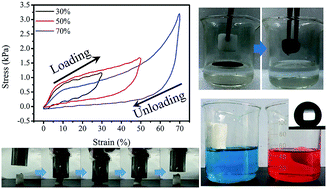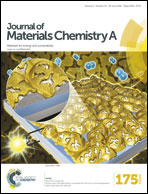Ultrasoft gelatin aerogels for oil contaminant removal†
Abstract
We demonstrated the preparation of a novel aerogel simply by cross-linking a gelatin physical gel with formaldehyde (cGel) and using a subsequent freeze-drying procedure. A hydrophobic absorbent material (MTCS-cGel aerogel) was further obtained by thermal chemical vapor deposition (CVD) of methyltrichlorosilane (MTCS). Rheological tests were carried out to investigate the cross-linking between gelatin and formaldehyde. Fourier transform infrared spectroscopy (FT-IR), scanning electron microscopy (SEM), energy-dispersive X-ray spectroscopy (EDX) and wettability of oil and water results proved that successful silanization occurred on/in the aerogels. These results also indicated that the MTCS-cGels had low densities (5–8 kg m−3), high porosities (>95%) with uniform pore sizes, and unique laminar/fibrous 3D networks. The oleophilic aerogels possessed high oil absorption capacities of 70–123 times that of their dry weights. Furthermore, the absorbents exhibited excellent elasticity and ultrasoftness with a stress of only 2.0 kPa at 60% strain. This property endowed the aerogels with super-recyclability where 83–85% of their full absorption capacity was maintained after 5000 times of compression. The high oil absorption performance, super-recyclability, sustainability, biodegradability and cost-efficiency make this novel absorbent a promising candidate for large-scale oceanic oil contaminant removal.


 Please wait while we load your content...
Please wait while we load your content...